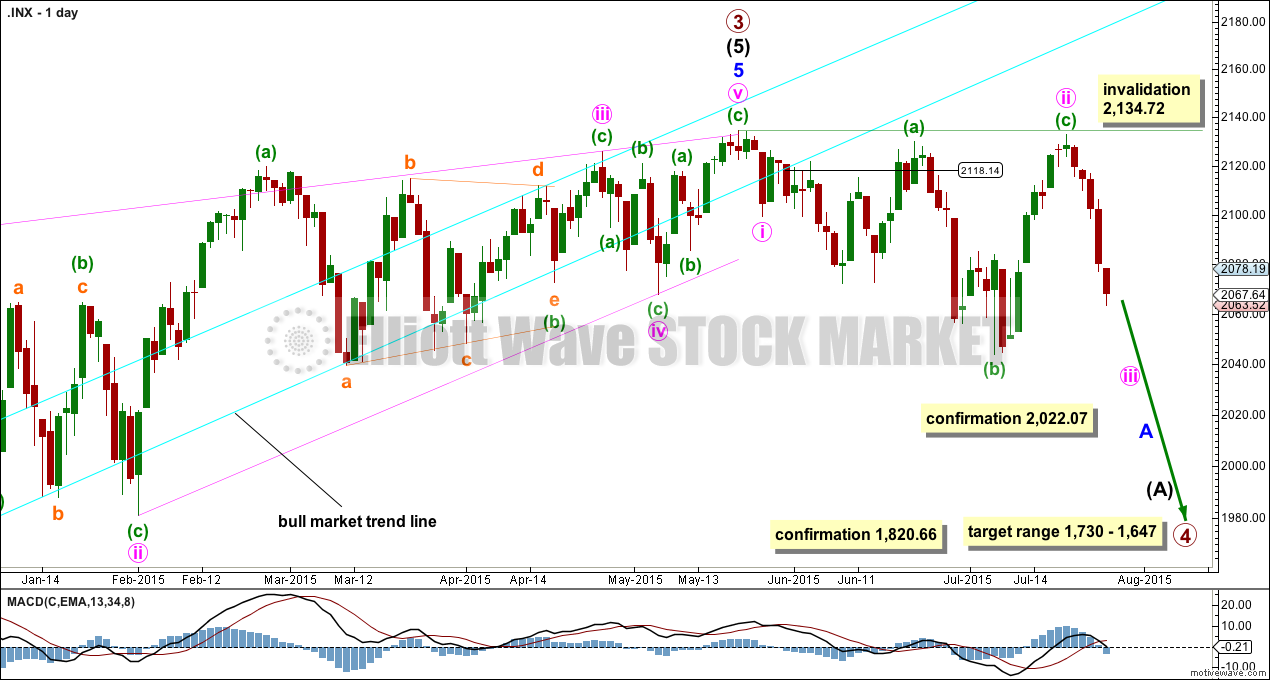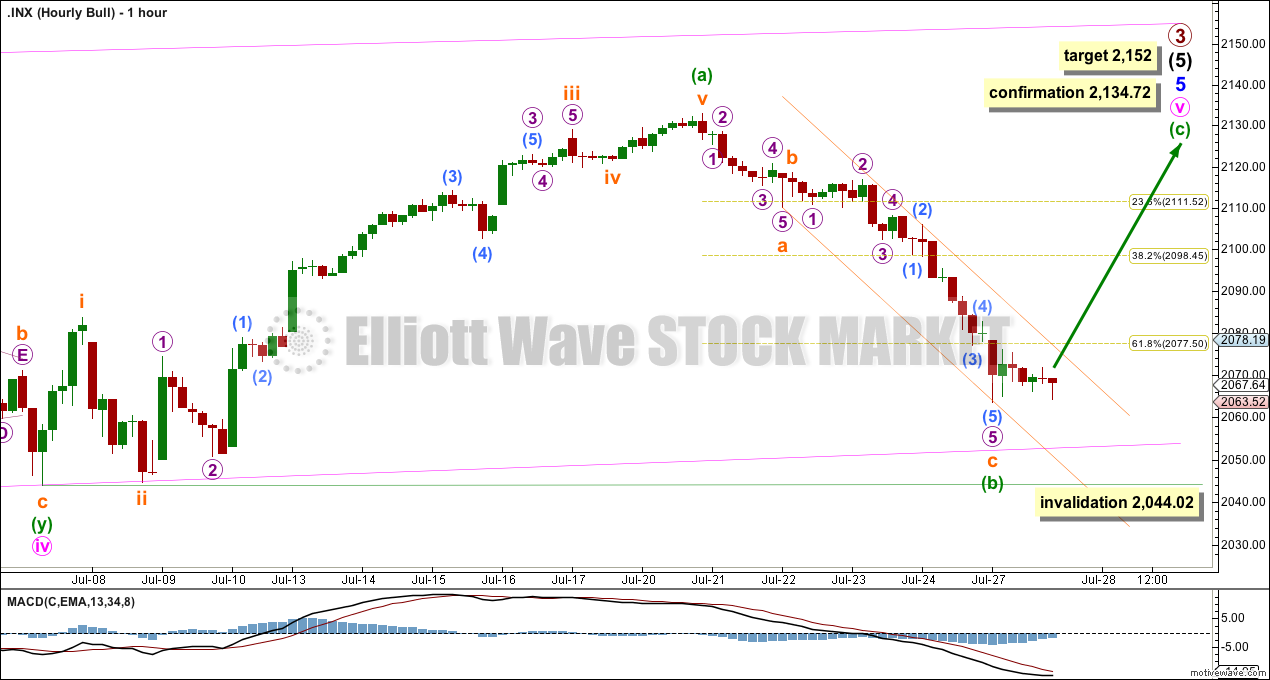More downwards movement was expected for Monday.
Summary: A first wave down is almost complete. When complete, a second wave correction will follow which may possibly be deep, but it does not have to be because it may be pulled down by a strong third wave. The second wave count expects upwards movement from here.
Changes to last analysis are bold.
To see a weekly chart and how to draw trend lines click here.
FIRST ELLIOTT WAVE COUNT
It is possible that the S&P has seen a primary degree (or for the bear count below a Super Cycle degree) trend change.
This wave count now has some confirmation at the daily chart level with a close more than 3% of market value below the long held bull market trend line.
Further confirmation would come with:
1. A new low below 2,044.02.
2. A new low below 2,022.07 to invalidate the alternate wave count.
3. A clear five down on the hourly chart.
4. A clear five down on the daily chart.
5. A new low below 1,820.66.
6. A break below the 50 week SMA on the weekly chart or the 200 day SMA on the daily chart.
As each condition is met the probability of a substantial trend change would increase.
At this stage, a trend change is looking somewhat likely so I’ll list points in its favour:
1. The long held bull market trend line, the strongest piece of technical analysis on ALL charts, has been breached now by a close more than 3% of market value.
2. There is quadruple negative divergence between price and MACD on the weekly chart.
3. There is double negative divergence between price and MACD on the daily chart.
4. There is persistent and strong negative divergence between price and RSI on the monthly chart. The last time this happened was October 2007 and we all know what happened after that…
5. A long held bull trend line on On Balance Volume going back to October 2014 has been breached, is no longer providing support, and is now providing resistance.
6. DJT has recently failed to confirm the continuation of a bull market. This does not indicate a bear market, but does indicate caution.
Primary wave 4 would be likely to end within the price territory of the fourth wave of one lesser degree: intermediate wave (4) has its price territory from 1,730 to 1,647.
Primary wave 4 would be likely to exhibit alternation to primary wave 2. Primary wave 2 was a 0.41 zigzag correction lasting 12 weeks, one short of a Fibonacci 13. Primary wave 4 may be more shallow than the 0.382 Fibonacci ratio, and may be a flat, combination or triangle, which are more time consuming structures than zigzags so it should be longer in duration than primary wave 2. Primary wave 4 may last a Fibonacci 21 weeks in total, 1.618 the duration of primary wave 2.
Minute wave iii may only subdivide as an impulse. It is normal for the S&P 500 to show the subdivisions of its third waves at minute degree on the daily chart, so it should be expected that minuette wave (ii) will show up with at least one green daily candlestick.
Minuette wave (i) is close to completion. When subminuette wave iv is over, then subminuette wave v downwards should end it. I cannot calculate a target for subminuette wave v to end until I know where it begins. Subminuette wave v is most likely to reach equality in length with subminuette wave i, so it is most likely to be 22.82 in length. Subminuette wave iii is 4.75 points short of 2.618 the length of subminuette wave i.
The channel about minuette wave (i) is a best fit. When this channel is clearly breached by upwards movement (not sideways) that may indicate the end of minuette wave (i) and the start of minuette wave (ii).
Minuette wave (ii) may end at either the 0.382 or 0.618 Fibonacci ratios of minuette wave (i). Second waves normally are deep, but this one may not necessarily be deep due to a strong downwards pull from minute wave iii.
Minuette wave (ii) should last at least one day and more likely a Fibonacci three or five days in total. It may not move beyond the start of minuette wave (i) above 2,132.82.
SECOND ELLIOTT WAVE COUNT
The ending contracting diagonal may still be incomplete. Ending diagonals require all sub waves to subdivide as zigzags, and the fourth wave should overlap first wave price territory. It is Elliott wave convention to always draw the diagonal trend lines to indicate a diagonal structure is expected.
My labelling here of minute wave iv within the diagonal as a double zigzag relies upon the interpretation of “double and triple zigzags take the place of zigzags” (“Elliott Wave Principle” by Frost and Prechter, 10th edition, page 91) to be true for zigzags within diagonals. This wave down may also be labelled as a single zigzag, but that does not have as neat a fit as a double zigzag.
The diagonal trend lines are no longer clearly converging. This reduces the probability of this wave count.
If it moves any lower, then minute wave iv may not be longer than equality in length with minute wave ii at 2,022.07. If it is over here, then minute wave v up also has a limit and may not be longer than equality with minute wave iii at 2,197.84.
The best way to see where and when upwards movement may end is the upper diagonal i-iii trend line. It is very likely to be overshot. Upwards movement may find resistance at the long held bull market trend line.
A-B-C of a zigzag and 1-2-3 of an impulse subdivide in exactly the same way. The subdivisions on the hourly chart for this downwards movement is seen in exactly the same way for both wave counts and the best fit channel is the same.
Minuette wave (b) still subdivides best as a completed zigzag, now reaching below the 0.618 Fibonacci ratio of minuette wave (a). While it is still more likely that this B wave is over, it is possible that it may continue sideways as a flat, combination or triangle.
The degree of labelling within minuette wave (b) may still be moved down one degree. This zigzag may be subminuette wave a of a flat correction or triangle, or it may be subminuette wave w of a double combination. It is now unlikely to be subminuette wave w of a double zigzag, because the correction is already very deep and a second zigzag is no longer required to make it deeper.
To confirm that minuette wave (b) is over the orange channel needs to be clearly breached by upwards (not sideways) movement, and the upwards movement must subdivide clearly as a five wave structure on the five minute chart.
While there is zero confirmation that minuette wave (b) is over, it must be accepted that it may yet move lower, but not beyond the start of minuette wave (a) below 2,044.02.
If minuette wave (b) is over here, then at 2,152 minuette wave (c) would reach equality in length with minuette wave (a).
For this second wave count, if downwards movement continues from here, then it should find strong support at the lower pink ii-iv diagonal trend line. Diagonals normally adhere well to their trend lines. If price breaks clearly below that trend line, then this wave count will reduce in probability.
Minuette wave (b) may not move beyond the start of minuette wave (a) below 2,044.02.
BEAR ELLIOTT WAVE COUNT
The subdivisions within cycle waves a-b-c are seen in absolutely exactly the same way as primary waves 1-2-3 for the main wave count.
In line with recent Grand Super Cycle wave analysis, I have moved the degree of labelling for the bear wave count all up one degree.
This bear wave count expects a Super Cycle wave (c) to unfold downwards for a few years, and if it is a C wave it may be devastating. It may end well below 666.79.
However, if this wave down is a Super Cycle wave (y), then it may be a time consuming repeat of the last big flat correction with two market crashes within it, equivalent to the DotCom crash and the recent Global Financial Crisis, and it may take another 8-9 years to unfold sideways.
Within the new bear market, no second wave correction may move beyond the start of its first wave above 2,134.72.
The second wave count above works in the same way for this bear wave count.
TECHNICAL ANALYSIS
ADX is beginning to slightly turn up, and now indicates the early stages of a trend may be beginning. Waiting a little for clarity may be a good idea, or a trend following system may now be used. The trend would be down.
Because there is not yet a correction on the daily chart within the possible new downwards trend, it is not possible to draw a reasonable trend line showing where price may find resistance. The risk here is that the first correction to unfold may move price substantially higher, up to but not above 2,132.82.
Downwards movement may be finding support at the 200 day SMA. A conservative approach to this potential new trend would be to wait for some confirmation; a break below the 200 day SMA and the lower red line of support would provide confidence in a downwards trend.
As price falls volume is rising. This fall in price is supported by volume. However, this has happened before recently for the S&P 500 and was followed by a swing up to new all time highs. The red arrow shows a prior all time high which came on declining volume, and was followed by five down days all on increasing volume. This is exactly the opposite of a normal volume profile. It was followed soon after by new all time highs. At this time volume may not be a reliable indicator.
On Balance Volume may be a better indicator. It showed where upwards movement recently ended: price turned when OBV touched its long held orange trend line.
If OBV breaks below its shorter green trend line, then that would be more bearish indication.
RSI is comfortably above 30. There is plenty of room for this market to fall.
A note on Dow Theory: for the bear wave count I would wait for Dow Theory to confirm a huge market crash. For that to be confirmed the following new lows are needed:
S&P500: 1,820.66
Nasdaq: 4,116.60
DJT: 7,700.49
DJIA: 15,855.12
At this time DJT is closest, but none of these indices have made new major swing lows yet.
This analysis is published about 12:44 a.m. EST.







Upwards movement looking quite deep for a sub-minuette correction. Either minuette two has arrived, or we are now in minute C up I presume.
Yes, minuette wave (ii) or minuette wave (c).
So far it’s just under the 50% mark of the prior move down, so so far it can be classified as relatively shallow.